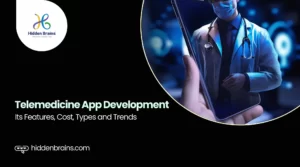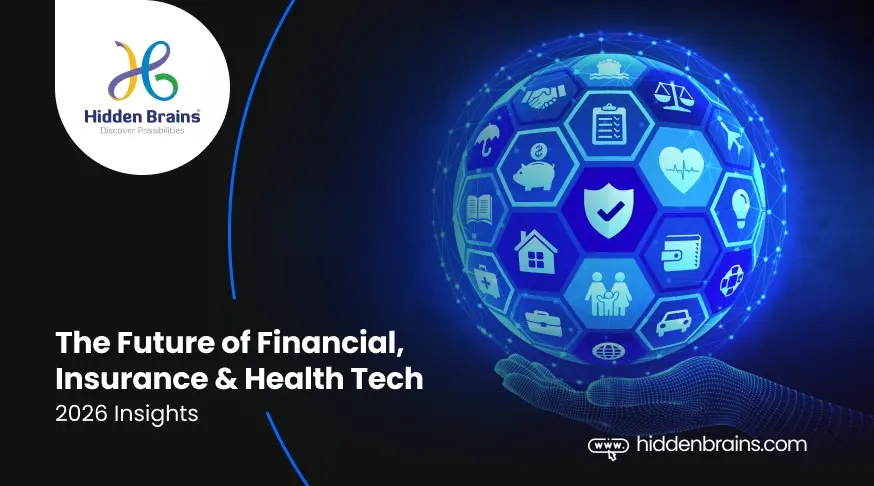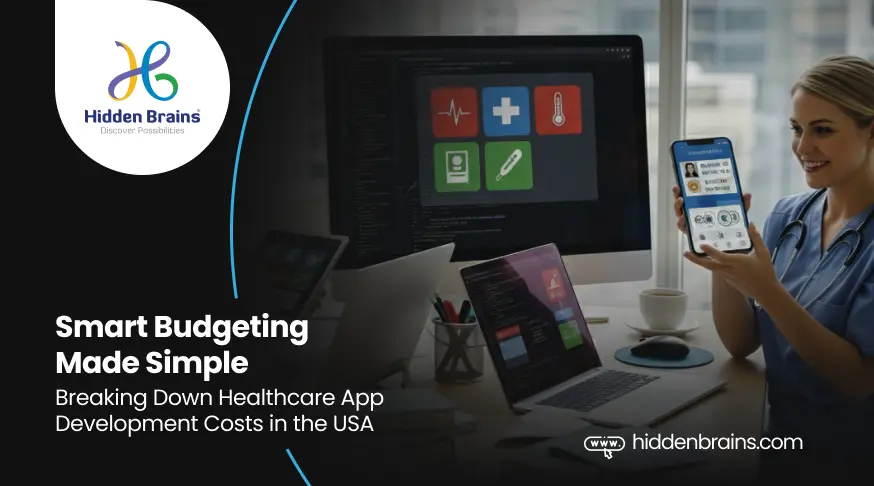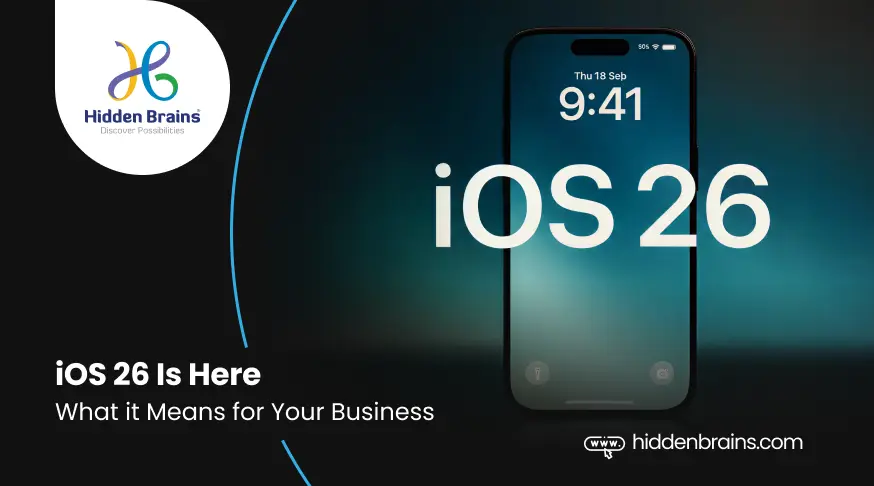Quick Summary
The healthcare industry is rapidly shifting toward virtual care, and telemedicine apps are leading the change. These apps make healthcare faster, easier, and more accessible, connecting patients and doctors anywhere, anytime. This blog explores everything you need to know about telemedicine app development, from process and features to cost and monetization. With over two decades of expertise, Hidden Brains helps businesses build secure, HIPAA-compliant telehealth solutions that boost engagement and revenue. Ready to transform healthcare digitally? Let’s make your telemedicine app!
Have you been in the healthcare industry and are looking for a digital transformation solution that can perfectly align with the changing customer needs? Investing in telemedicine app development will be a worthwhile investment!
In recent years, there’s been a big shift towards telemedicine. It’s a fancy term for using technology to see doctors and monitor health from afar. This change isn’t just about making healthcare easier to access but also about getting patients more involved in the communication process. In addition, several tasks have been automated to save time and ensure an easy, quick, and simple approach to healthcare.
“With more businesses looking for remote healthcare options, creating a telemedicine app is a smart move in 2024. Being one of the leading Telemedicine app development companies based, we allow businesses to develop custom solutions.
With two decades of experience in mobile app development services, our team is trained to customize telemedicine apps from scratch. To provide real insights into telemedicine app development, here we have created a complete guide explaining everything from the app development process to its total development cost.”
Ready to tap into the booming telemedicine app development market? Let’s leverage our Healthcare IT Solution services to customize the telemedicine app that adds edge to your business growth.
Let’s understand this further
What is Telemedicine App Development and Why It Is Needed?
Telemedicine apps are highly quality-driven software solutions, developed to offer remote consultation, remote patient monitoring services, and more.
The simple logic of developing telemedicine applications is to seamlessly connect healthcare providers remotely with patients. It leverages advanced digital technologies to make these app platforms work.

Source: code-care
Telemedicine apps aren’t just about virtual doctor visits but they offer a whole array of services beyond that. From virtual care and monitoring to remote counseling and prescription renewals, these apps cover a lot of ground.
The beauty of telemedicine apps is their convenience and speed. Now patients no longer have to deal with long waits or travel far distances to see a doctor. Instead, they can access expert medical advice in real-time right from their homes, without any hassle.
But is it worth investing in?
Let’s analyze the telemedicine app market…
Market Analysis: Determining the Scope of Telemedicine Apps
Surprising how telemedicine apps can be a game-changer for startups? Well, the use of telehealth applications has skyrocketed during the pandemic and still experiencing high demand. But if you are still hesitating to hire a mobile app developer, you need to look at the key market stats…
- 80% of consumers have used a telemedicine app at least once.
- It is estimated that the telemedicine app market is estimated to reach $427.9 billion by 2032.
- 82% of patients believe that developing a telehealth app has smoothened the process of healthcare and enabled them to seek doctor consultations.
- 69% of patients agree to have a virtual consultation with their physicians over virtual visits.
- 93% of healthcare providers believe that telehealth apps are a widely accepted method of patient care and 60% are very satisfied with their virtual experience.
With these facts and stats, it is fair enough to say that considering investing in telemedicine app development is a sensible decision. It can effectively help you deliver care in real time for all aging and chronic health issues. But how to get started with it?
Making Possible to Launch Telemedicine App In 7 Simple Steps
Developing a telemedicine app can be a simple process. Hidden Brains, which has excelled in customizing applications so over two decades can help you launch a telemedicine app in simple 7 steps.
Here are the quick steps to create a telemedicine app:
- Determining and analyzing the business objectives
- Layout app functionalities and compliance requirements
- Plan HIPAA-compliant SDLC and set budget limits and milestones
- Design and develop Patient-Doctor centric app panels
- Coding the app backend and considering app integration with other hospital system
- Testing the app on multiple platforms to ensure seamless performance
- Considering the location of the client, we seek for certifications including 21CFR 11, IEC 82304-1:2016)
Usually, this app development process takes up to 5-7 months. As we are working with a 700+ dedicated team of engineers, therefore we have deployed a complete team on a project. For telemedicine app development, you will need a team of project managers, backend/frontend developers, UI/UX designers, app testers, and more.
Further, the estimated cost of creating a telemedicine app typically ranges between $75,000*+ to $100,000*+ depending upon the complexity of the app requirements. For exact cost estimation, you can book a free consultation slot.
So now you know the process, cost, and timeline of developing a telemedicine app, but how would you decide what type of app you need to invest in?
Let’s discuss this below!

Let our experts provide the estimation!
4 Types of Telemedicine App Development
There is a wide range of telemedicine apps that you can consider investing in with specific functionalities and features. However, here we are discussing the few major categories that have potential markets.

Source: theonetechnologies
Types of Telemedicine Applications for Startups
- Live Video: Live, two-way interaction between a person (patient, caregiver, or provider) and a provider using audiovisual telecommunications technology.
- Store-and-Forward: Transmission of recorded health history to a practitioner for evaluation outside of a real-time or live interaction.
- Remote Patient Monitoring: Personal health and medical data collected in one location is electronically transmitted to a provider to track healthcare data for a patient once released to home or a care facility, minimizing readmission rates.
- Mobile Health (mHealth): Health care and public health practice and education using mobile devices ranging from targeted text messages to alerts about pandemics.
Technology and digital forces can quickly accelerate across the healthcare industry, and portions of healthcare will be virtualized. The impact will be profound with the result geared towards a user-centric model and empowered consumers.
Though hiring an app developer enables you to build any type of telemedicine app the success of your app is majorly dependent on the features and functionalities you prefer integrating into the app.

Looking to build your app?
Try Out Hidden Brains’ telemedicine solutions!Essential Telemedicine Software Features
While developing a telemedicine app, keep in mind that features and functionalities are the success-driving elements. The more precise features you consider in-app, the better chance you will have to establish a name in the market.
So here we have categorized the features and functionalities you would require at each panel.
a) Visit Scheduling Panel:
- Allow patient to schedule, reschedule, and cancel appointments in the app
- Set reminder notifications for upcoming appointments
- Automated physician referral processing and assigning physicians as per request as well
b) Doctor-Patient Communication Panel:
- List down pre-visit patient questionnaires
- Offer secure video chats for online appointments
- Facilitate feature for instant message and file sharing between doctor and patient
- ML-powered speech recognition tool for speech-to-text transcription
- Storage of appointment recordings and chat history
c) Treatment Planning Panel:
- Allow the app to access patient profiles and medical records within the app
- Create visit summaries date-wise and add points to action
- Template-based or manual creation of treatment and medication plans
- Uploading E-prescriptions of medications and keeping them saved in a user profile.
d) Disease Management Panel:
- Allow the app to track the symptoms of patients
- Collection of patient insights through smart devices or manual entry
- Medication intake log and reminders
- Nutrition and Physical Activity Journal
e) Analytics Panel:
- AI-driven analysis of health data for accurate diagnoses and personalized treatment
- Dashboards displaying patient health state based on records, symptoms, and vitals
- Alerts for abnormal patient vitals or symptoms
f) Patient Knowledge Base Panel:
- Knowledge base with self-help guides and disease-specific articles
- General and disease-specific physical and mental exercises
- AI-powered chatbots for tailored educational recommendations
- AR/VR-assisted immersive learning for patient understanding
g) Reputation Management Panel:
- Post-visit review system for doctor performance evaluation
- Ensuring authenticity and credibility of patient reviews
- Displaying reviews on doctor profiles
- Searching and filtering doctors based on reviews
h) Billing and Insurance Panel:
- Instant payment processing via connected gateways
- Support for multiple payment methods
- Access to explanations of benefits
- Patient eligibility check and insurance verification
- Patient access to personal insurance information (for provider-owned apps)
i) Security and Compliance Panel:
- End-to-end data encryption
- Role-based app access and identity management
- Multi-factor authentication for users
- Compliance with HIPAA, HITECH, GDPR, and PCI DSS
These are the must-have features that you need to integrate in telemedicine app development. Though these are complex to create, therefore we always recommend hiring software developers to customize an app. But how will you get a competitive edge?
Let’s take a look at the emerging technologies empowering the telehealth industry…
Top Technology Trends Used for Telemedicine App Development
A Plethora of emerging technologies is boldly paving their way into the healthcare industry, AI, IoMT, Blockchain, and Big Data are the top trends to transform the healthcare domain.

Source: gloriumtech
A. AI-Powered Chatbots
With the rise of Artificial intelligence, machine learning, and AI chatbots, the initial patient interaction will be done through artificial intelligence involving asking frequently asked questions when specialist healthcare providers are not available. Routine processes will be automated to improve efficiency.
B. Internet of Medical Things
Connected devices such as fitness trackers, smartwatches, and wearable devices can consistently provide patient information. IoMT combined with big data analytics will help anticipate health trends to improve efficiencies.
C. Blockchain
Blockchain will provide a secure ledger to store transactions and conversation history from the telemedicine platform giving the layer of security.
D. Big Data
The healthcare industry is based on patient data and scrutinizing the vast pool of data with manual process is a wrong approach. Big Data uses the database and analyzes it to offer insights into patient trends, treatment effectiveness, and healthcare resource utilization. This data-driven approach enhances decision-making and improves patient outcomes in telemedicine applications.
Using the Best Monetization Approach For Telemedicine Apps
The ultimate goal of developing a telemedicine app is to cater to care and generate profit for your business. But how can you make money through a telemedicine app?
When it comes to determining the best monetization strategy for telemedicine software products, Hidden Brains recommends the following approaches:
1. Pay-per-Appointment
In this model, users simply pay a see fee for each appointment they book. The partial amount of the appointment booking fees goes to the company that created the software every time. Also, there won’t be any fixed cost as it might change depending on things like the type of appointment or how experienced the healthcare provider is.
2. Subscription-Based Approach
Under this model, users pay a recurring subscription fee to access telemedicine services provided by the software product company. You can provide Subscription plans on a weekly, monthly, or annual basis depending upon the number of consultations per period. With this approach, patients can pay one-time fees for all the consultations and the company will get a good profit from it.

Want to boost your healthcare business?
Type of Professional Services Required for Telemedicine App Development
If you have finally decided on telemedicine app development, keep in mind that the ultimate success depends upon the type of professional services you engage for your project. But what type of professional services will best fit your requirements? Well, mobile app developers with the right experience and expertise will ensure a smooth and efficient process. Hidden Brains offers you a broad suite of services tailored to meet the unique requirements of healthcare providers and patients:
a) Telemedicine App Consulting Services:
- Hidden Brains assists in identifying specific requirements and outlining essential features for your telehealth app.
- To support your telemedicine app on multiple platforms, our experts guide you in selecting the right technology stack and robust architecture.
- To stay updated, we recommend incorporating cutting-edge technologies like IoT, AI, ML, and more in telemedicine apps.
- Hidden Brains provides insights into healthcare industry regulations, ensuring your app complies with standards such as HIPAA and HITECH.
- Our team helps plan the telemedicine app development process to ensure a smooth and efficient execution.
b) Telemedicine App Development Services:
- To understand your requirements and outline a feature set, our team will work closely with you.
- To uplift user experience, our UI/UX designers build intuitive interfaces for both healthcare providers and patients.
- We manage the development and rigorous testing of your telemedicine app to ensure excellent performance.
- Extend the functionality of your telehealth app by integrating it with third-party software like EHR and CRM systems and other existing systems.
- To make your app run smoothly, we provide ongoing support and maintenance as required.
c) Telemedicine App Modernization Services:
- In case you already have an app and looking to modernize it then Hidden Brains will help in identifying pain areas for improvement in your existing telemedicine app and propose solutions to enhance its performance and functionality.
- We streamline the app architecture to improve scalability and flexibility, ensuring it can accommodate future growth and changes.
- Our designers revamp the user interface to modernize the app’s look and feel, enhancing user engagement and satisfaction.
- We focus on advanced features like advanced data analytics and remote patient monitoring (RPM) to keep your telemedicine app competitive and relevant.
- We incorporate technologies such as speech recognition, interactive visualizations, and blockchain storage to enhance the capabilities of your telehealth platform.
Frequently Asked Questions
If you still have any doubts about telemedicine app development then you can consider this FAQs section to get all answers to your questions.
Why You Should Consider Developing a Telemedicine App?
Migrating your healthcare service to a telemedicine app will assure a wide range of benefits to patients and healthcare providers including:
– Reduced wait times for appointments.
– Quicker access to high-demand clinical specialists.
– Reduced ER trips, reducing costs for hospitals and patients worth thousands of dollars per clinical encounter.
– Improved convenience of care for patients with no need to meet their provider for routine visits in person.
– Save on travel costs and reduce overhead for both clinical care providers and patients.
– Improved access for patients in distant or rural locations
– Improved clinical outcomes.
– Reduced in-office patient no-shows.
What are the Core Benefits of Outsourcing Telemedicine App Development To Hidden Brains?
The biggest benefit of outsourcing telemedicine app development projects to Hidden Brains is they provide access to a 700+ pool of developers with a minimum of 5+ years of industry experience.
Depending upon your project requirements, they allow you to hire resources based on hourly, fixed, and monthly billing. No matter how complex your requirements are, they have a capable team to handle it with ease.
How Does Hidden Brains Ensure Data Security and Safety in Telemedicine App Development?
At Hidden Brains, we prioritize data security and safety throughout the telemedicine app development process. Here are the few best practices we follow to ensure utmost security:
– We strictly adhere to healthcare industry regulations such as HIPAA and HITECH to safeguard patient data.
– To keep user data secure and protected we implement end-to-end encryption.
– We employ role-based control mechanisms in app and restrict access to confidential data without authorized details.
– We design a secure architecture to protect an app from cybersecurity risks.
– We conduct regular security audits and assessments to identify and address vulnerabilities proactively.
Conclusion
Hopefully, this guide has provided you with all the insights into developing a telemedicine app and its future market scope. Still practically executing all this information will remain challenging for startups. So if you are looking for telemedicine app development or want to upgrade your app, then it is recommended to hire a mobile app development company.
Hidden Brains is one such trusted telemedicine app development company offering unmatched quality solutions to startups, SMEs, and leading healthcare institutions. So if you have any project idea ready with you and looking for a capable tech team to bring it to life, then contact us or drop a query below.






























































































![Sales & Distribution [Oil & Gas] Sales & Distribution [Oil & Gas]](https://www.hiddenbrains.com/blog/wp-content/themes/blankslate/assets/images/sales_and_distribution-icon.74d08193.svg)

![Fluid Terminal Management [Oil & Gas] Fluid Terminal Management [Oil & Gas]](https://www.hiddenbrains.com/blog/wp-content/themes/blankslate/assets/images/fluid_terminal_management-icon.4b3a27a4.svg)































![Sales & Distribution [Oil & Gas] Sales & Distribution [Oil & Gas]](https://www.hiddenbrains.com/blog/wp-content/themes/blankslate/assets/images/sales_and_distribution-icon.74d08193.svg?1.0.0)
![Fluid Terminal Management [Oil & Gas] Fluid Terminal Management [Oil & Gas]](https://www.hiddenbrains.com/blog/wp-content/themes/blankslate/assets/images/fluid_terminal_management-icon.4b3a27a4.svg?1.0.0)
























































































































































































